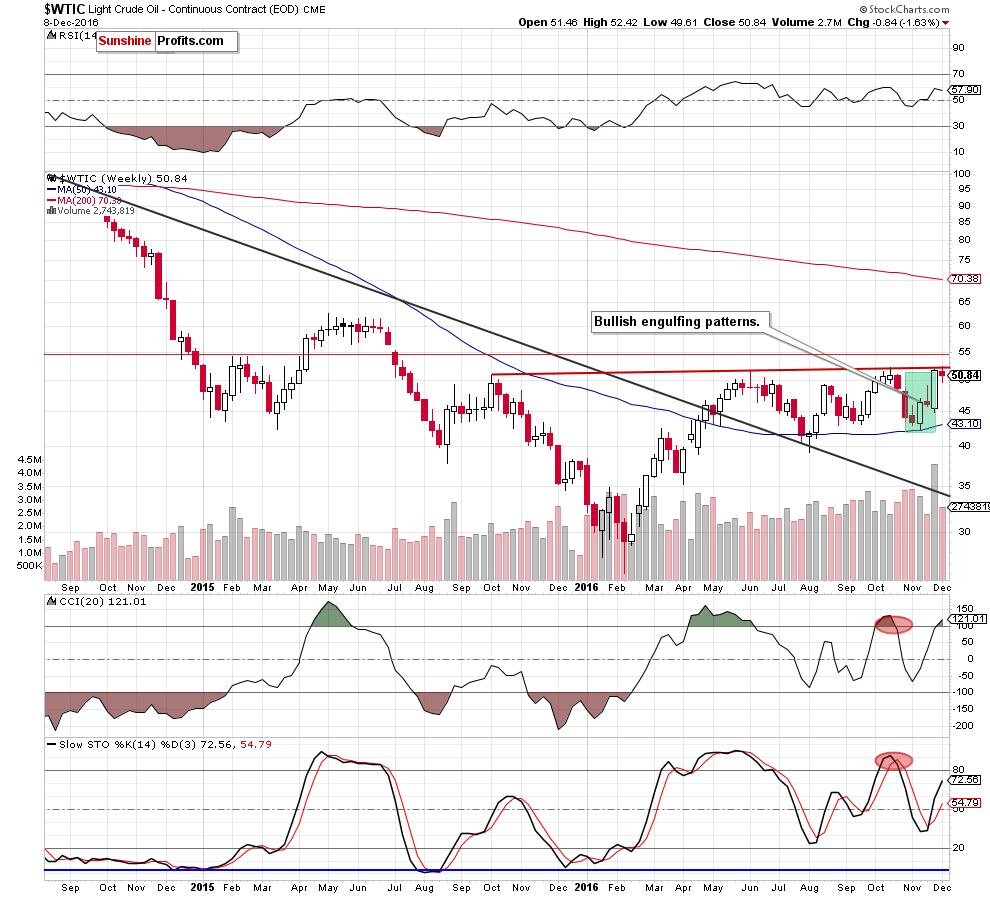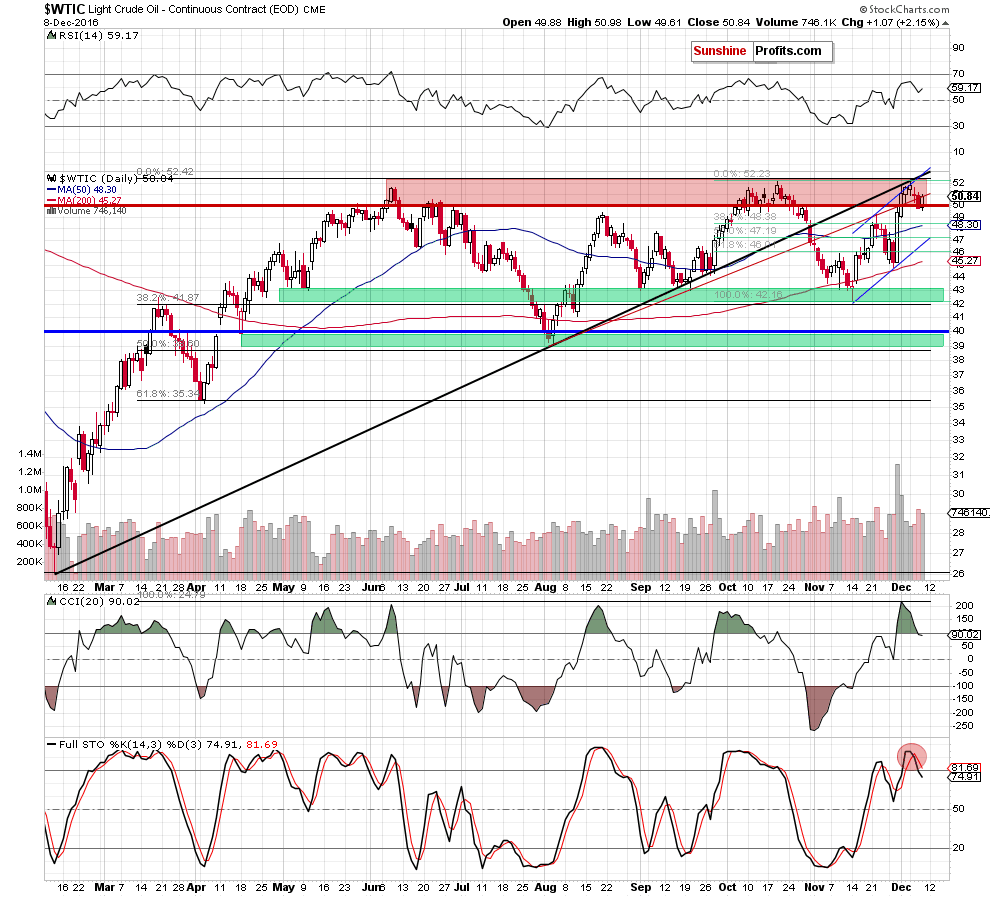Trading position (short-term; our opinion): Short positions (with a stop-loss order at $54.51 and initial downside target at $45.43) are justified from the risk/reward perspective.
On Thursday, crude oil bounced off session’s lows and came back above the barrier of $50, but did this increase change anything in the short-term picture of the commodity?
Let’s take a look at the charts below to find out (charts courtesy of http://stockcharts.com).


Looking at the above charts, we see that crude oil moved higher and came back above the barrier of $50 yesterday. In this way, light crude invalidated earlier breakdown under this technically important level, which triggered further improvement and a climb to an intraday high of $50.98.
But did this increase change anything important in the short-term picture of the commodity? In our opinion, it doesn’t. Why? Firstly, yesterday’s increase took the black gold to the previously-broken short-term red rising line, which looks like a verification of earlier breakdown. When we take a closer look at the daily chart, we can notice a similar price action in the previous month. Back then, a comeback to this line triggered a reversal and a decline to the 200-day moving average, which suggests that we may see a similar decline from current levels in the coming days.
Secondly, invalidation of the breakout above the Oct high and the upper border of the blue rising trend channel and its negative impact on the price are still in effect, supporting oil bears. Thirdly, the key resistance lines (the long-term red line marked on the weekly chart and the medium-term black line seen on the daily chart) continue to keep gains in check, which means that as long as there won’t be a breakout above them lower prices of light crude are very likely. Fourthly, the CCI generated a sell signal (while the Stochastic Oscillator dropped under the level of 80), giving oil bears another reason to act. Fifthly, the size of the volume that accompanied yesterday’s increase was smaller (compared to what we saw during declines), which doesn’t confirm oil bulls’ strength at the moment.
Taking all the above-mentioned negative signals, we believe that another attempt to move lower is just around the corner and short (already profitable) positions continue to be justified from the risk/reward perspective.
Summing up, although crude oil moved little higher yesterday, the outlook for the commodity remains bearish as the black gold remains below the key resistance line. Additionally yesterday’s price action looks like a verification of earlier breakdown, which increases the probability of another downward move and suggests that the profits from our short position in crude oil will increase further before this trade is over.
Very short-term outlook: bearish
Short-term outlook: mixed with bearish bias
MT outlook: mixed
LT outlook: mixed
Trading position (short-term; our opinion): Short positions (with a stop-loss order at $54.51 and initial downside target at $45.43) are justified from the risk/reward perspective. We will keep you – our subscribers – informed should anything change.
On an administrative note, due to my travel plans, there will be no regular Oil Trading Alerts since Monday to Thursday, but if the situation changes dramatically, we will send you a quick note with our latest analysis and thoughts on that matter.
As a reminder – “initial target price” means exactly that – an “initial” one, it’s not a price level at which we suggest closing positions. If this becomes the case (like it did in the previous trade) we will refer to these levels as levels of exit orders (exactly as we’ve done previously). Stop-loss levels, however, are naturally not “initial”, but something that, in our opinion, might be entered as an order.
Since it is impossible to synchronize target prices and stop-loss levels for all the ETFs and ETNs with the main market that we provide this level for (crude oil), the stop-loss level and target price for popular ETN and ETF (among other: USO, DWTI, UWTI) are provided as supplementary, and not as “final”. This means that if a stop-loss or a target level is reached for any of the “additional instruments” (DWTI for instance), but not for the “main instrument” (crude oil in this case), we will view positions in both crude oil and DWTI as still open and the stop-loss for DWTI would have to be moved lower. On the other hand, if crude oil moves to a stop-loss level but DWTI doesn’t, then we will view both positions (in crude oil and DWTI) as closed. In other words, since it’s not possible to be 100% certain that each related instrument moves to a given level when the underlying instrument does, we can’t provide levels that would be binding. The levels that we do provide are our best estimate of the levels that will correspond to the levels in the underlying assets, but it will be the underlying assets that one will need to focus on regarding the sings pointing to closing a given position or keeping it open. We might adjust the levels in the “additional instruments” without adjusting the levels in the “main instruments”, which will simply mean that we have improved our estimation of these levels, not that we changed our outlook on the markets.
Thank you.
Nadia Simmons
Forex & Oil Trading Strategist
Przemyslaw Radomski, CFA
Founder, Editor-in-chief, Gold & Silver Fund Manager
Gold & Silver Trading Alerts
Forex Trading Alerts
Oil Investment Updates
Oil Trading Alerts



